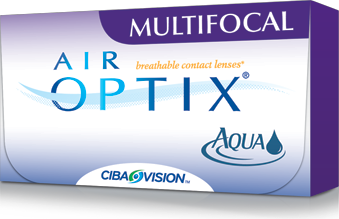 Monovision Contact Lenses
Monovision Contact Lenses
Monovision Contact Lenses Provide Satisfactory Near Vision for Many in their 40's
Monovision is a certain method of fitting contact lenses on a patient with presbyopia. Presbyopia is the gradual decline in near vision after the age of 40, which is due to loss of elasticity of the crystalline lens inside the eye. The first sign of presbyopia is the need to hold reading material, especially smaller print, further away than you used to. Eventually reading glasses or bifocals will be necessary to read except in the case of a near-sighted (myopic) person who may be able to remove the distance glasses to read. Either way, computer work and reading will become much more difficult with contact lenses if they are correcting the distance vision only.
Monovision provides vision so that both eyes still have vision at both far and at near.  However, in monovision the dominant eye will have better vision faraway and the non-dominant eye will have clearer vision at near.
However, in monovision the dominant eye will have better vision faraway and the non-dominant eye will have clearer vision at near.
Monovision Technique and Exam
A monovision contact lens fit consists of fitting the dominant eye with a contact lens for far vision and the other eye with a contact for near vision. If a prescription is not needed for distance it would be possible to use one contact lens for near. This may seem like a strange method but it actually works very well. The reason you can get used to wearing a near and distance contact lens is because we all have a dominant eye. Our dominant eye is the one that primarily focuses on an image. The non-dominant eye helps as well but the brain pays much more attention to visual information coming from the dominant eye. The dominant eye has nothing to do with whether you’re right or left handed and it’s usually the eye used to look through a camera, telescope or gun sight.
Determine the Dominant Eye
One method of determining your dominant eye is the hole-in-the-hand trick.
- First hold your arms fully extended straight out in front of you with palms facing away.
- Now bring your first fingers and thumbs together creating a small hole between your hands.
- With both eyes open, center a small, distant object in the middle of the hole.
- Now close your left eye and then your right eye. When you close your non-dominant eye the object will stay in the middle of the hole. When you close you dominant eye you will no longer be able to see the object. So if you close an eye and the object stays in place and you can still see it through the hole then you are looking at it with your dominant eye.
- It’s important to make sure the object is far enough away. It may not work if you pick something too close.
When you are fit with monovision contact lenses, the doctor will always test which eye is dominant because that is the eye that will be fit with the distance contact lens. If the dominant eye was fit with a near lens then distance vision may be too blurred and the fit would not be successful.
Adapting to Monovision Contacts
It usually takes at least 1 to 2 weeks to adapt to monovision. The vision will continue to improve as the lenses are worn. At first it is possible to notice shadowing of images especially when reading and a slightly strange visual sensation that will improve over time.
As the brain and the visual system learn to adapt to the new vision correction, the monovision patient feels more and more natural with the correction. About 70% of patients adapt very well and feel very natural with monovision, especially in the early years of presbyopia.
Advantages of Monovision Contact Lenses
The major advantage of monovision is that it can be achieved using almost any contact lens on the market. It does not have to be an expensive, special multifocal contact lens. If you are a person who experiences frequent discomfort or dry eye with contact lenses then a monovision fit will provide many more options to choose from. If you have been wearing contact lenses for a long time and would like to stay with the same brand that is be possible with monovision. If you have astigmatism that must be corrected with contact lenses then monovision would be the only option aside from a custom multifocal toric lens which is much more expensive and complicated and offers a reduced chance of success.
Disadvantages of Monovision Contact Lenses
The monovision process may never provide “perfect” vision, but for most people it offers an acceptable and near normal vision that allows for functional vision throughout each day. Monovision may cause glare or halos at night and will decrease depth perception so someone who requires perfect vision or perfect depth perception may not be a good candidate. Someone that primarily functions with distance vision (e.g. professional truck driver) would not derive enough benefit to justify monovision.
As a person ages and the bifocal optical prescription gets stronger it can become more difficult for a person to adapt to monovision due to the bigger disparity between the two eyes.
If you are successful with a monovision contact lens fit then you would be a good candidate for monovision in LASIK surgery also! If you have ever considered having the procedure and you have presbyopia then you would have to get monovision LASIK in order to see distance and near. Monovision contacts should always be tried before having monovision LASIK.
Multifocal Contacts are an alternative to monovision contacts and when successful, multifocal contact lenses provide a better quality of vision for both distance and near vision.

